Beach Fishing Tips by Alvey Reels Australia
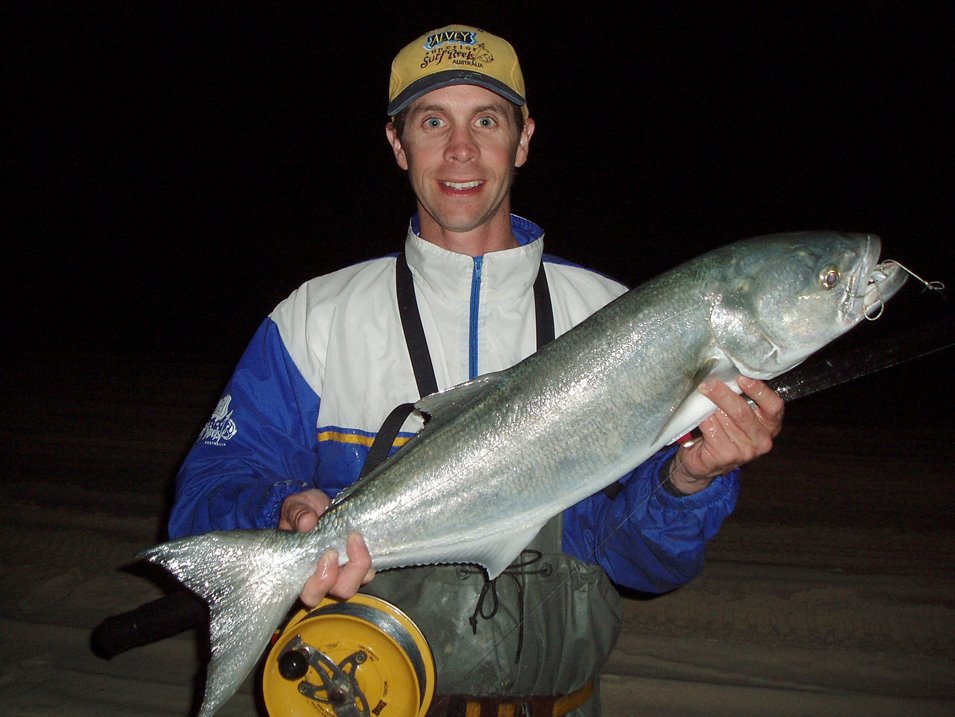
Written by Rob Duncan
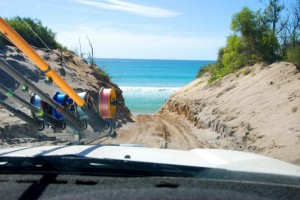
Sand between the toes, pristine surrounds, the abundance of fauna & flora and of course those beautiful starry nights could be just a couple of reasons many people find the attraction of ‘getting away’ from it all and heading to the beach so appealing. The beach is certainly a terrific place to unwind and relax however the beach has a secret… it’s a goldmine for the beach fishing enthusiast! Everything from fresh bait to fresh fish is available, it just takes a little practice and you too will be hooked on beach fishing!
Like any sport though, there are of course tips, tricks and advice that can enhance your performance. This article is a great place to start for any newcomer to beach fishing so I have tried to keep it basic, yet provide sufficient information to get you well on your way.
Its content comes from information I have gathered over many years while working for Alvey Reels Australia and I hope it helps make your beach fishing trip a success and ultimately rewards you with a better catch.
Before we hit the sand
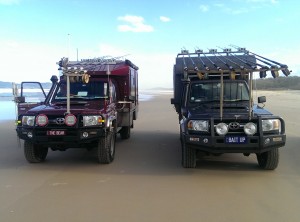
Driving on the beach can be a lot of fun however, it’s important to remember a few basic rules:
- Always check your local tide times and drive on a low or falling tide if you are towing or driving a long distance.
- Lower your tyre pressure to increase the longitudinal footprint of the tyre. This gives both better traction and more responsive steering on soft sand. I like to start at 20psi and find this is a great starting point but your vehicle, the terrain and brand of tyre will all play a part in deciding the best pressure for you.
- Never swerve sharply in the sand as this can cause tyres to bite in, thus risks rolling your vehicle. Just take your time and be careful.
- Never brake hard in the sand unless you absolutely have too, and if you do… hang on to the steering wheel firmly as it will try and turn.
- Always take extra food and water as the beach can be a remote place if things go wrong and your stay is extended.
- Have a reliable recovery gear, a quality strap and rated shackles and consider MaxTrax just in case you get stuck.
- Never wade out too deep into the ocean especially if you are unsure of currents or rips.
When to fish
Cooler months:
The drop in water temperature during winter is normally a trigger for an abundance of species in most areas. Fish like Tailor, Salmon, Bream and Tarwhine are just a few that come to mind and are more prolific during these cooler months. Winter also coincides with Westerly winds and predictable weather patterns making this time of year perfect for family camping trips as well. Don’t forget your woollies as the temperature on the beach can get much colder than in your lounge room at home.
Warmer months:
The great thing about summer is the nice long days and lovely balmy conditions. Fish such as whiting, swallowtail dart and flathead will be found on many beaches during these months. These fish are not only great eating but also terrific entry level species for the kids! Many resident Tailor can be found all year round in Southern Queensland and Northern NSW beaches so don’t discount these a target species too. Make sure you remember your hat, sunscreen and protective clothing to avoid severe sunburn.
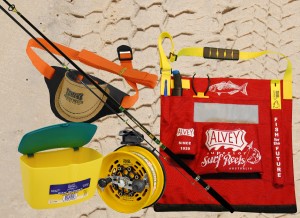
Beach Fishing Rods & Reel Selection:
You will find it necessary to have at least two outfits when beach fishing, one for flicking small baits into the low tide drains and gutters, the other for tossing big baits out ‘yonder’ in anticipation of something big!
Light Combo:
Ideally a fairly soft tipped rod of about 9’ or 10’6” coupled with a 5.5” or 6” Alvey reel is perfect for low tide work for chasing whiting or Swallowtail Dart. This outfit will allow you to walk along tirelessly while tossing small baits like pippies and beach worms into the shallows. Alvey’s Rod550 (9’) or Rod555 (10’6”) would make an ideal rod choice for this situation.
Surf Combo:
Beach Fishing the surf can be a little daunting for the uninitiated. Waves, sweep and wind are all factors that you may need to contend with so choose an appropriate rod that can handle these conditions. Rods of 12’ and 13’6” are most commonly used by surf fishermen as these larger rods have the length and power to cast your bait well out while still maintaining good line clearance above the waves. Alvey have a great selection of suitable rods which are specifically designed to suit Alvey reels and have low reel mounts and an ‘Open Runner’ which takes line pressure off the finger when winding in. Lighter 12’ Alvey rods include the beautiful ‘Bruce Alvey Special’ or Rod 625L series while the heavier Alvey 13’6” Custom Beach King is perfect for heavier beach fishing work. These rods are ideally matched with any 6.5” Alvey reel which have massive line capacity and provide you with the perfectly balanced surf outfit.
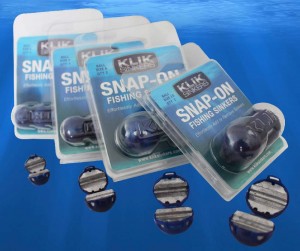 Terminal Tackle
Terminal Tackle
To help make your tackle selection easier I have put together two complete lists of terminal tackle that I would take on most beach fishing safaris. The first list is designed for the light beach work whilst the second is targeted towards heavier surf. I should mention that I don’t use the Paternoster style rigs which are common in our Southern States but prefer a rolling ball sinker with which I can walk the gutters to cover more ground.
Light Beach Fishing:
- Ball Sinkers in size 2 – 5 (I prefer the hinged snap on ‘Klik Sinkers’)
- Swivels in size 8 -12 depending on brand (Small is what you are after as they turn easier and produce less line twist in the surf).
- Single Hooks in size 1/0, 1, 2, 4, 6
- Red Whiting tube and beads
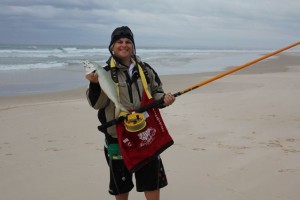 Heavy Beach Fishing:
Heavy Beach Fishing:
- Ball Sinkers size 6 – 10 (I prefer the hinged snap on ‘Klik Sinkers’)
- Swivels (8 – 12 as per Light Beach)
- Single hooks in size 4, 1, 1/0, 2/0
- 3 or 4 Gang Hooks in size 3/0 & 4/0 (Depending on the size of Pilchards)
- Twin hook rigs (Make yourself) in size 5/0 (top) and 3/0 (Bottom) ganged with a swivel in between. The smaller 3/0 will also account for a number of big Bream!
- A couple of strong single 8/0 and 10/0 hooks (For Snell Rig for Jew)
- Short wire trace (Black) for toothy critters in lighter line class of about 30Lb
- Soft Lumo Beads used either side of the sinker which aid in cushioning
- 40Lb Fluoro Carbon Leader
Line Choice
Today there is massive choice of fishing line available to the fisherman but I will help you out by reducing that choice by half…forget braided lines on the beach and choose a monofilament line if you are using bait! There are a number of reasons I choose not to use braided line on the beach, the first is long rods naturally hold the line very high and due to braided lines light weight it tends to get larger wind arcs than monofilament, this reduces feel thus contradicting the very reason it was designed (contact fishing with lures). The second reason is small amounts of weed can commonly be found on our coastal beaches and this stuff loves getting caught up in your expensive braid making tiny little balls that can be almost be impossible to remove. Oh, I’ll through in a third reason…have you ever tried tying braid in the dark?
So now that we’re looking at monofilament lines, what are our options? Personally I love the Australian made Platypus range of fishing lines. The fact that it is made here in Australia is really an added bonus, the true quality of the line is superb and I have been using it for years!
There are really three great choices for beach fishing, all of which have subtle differences as mentioned below:
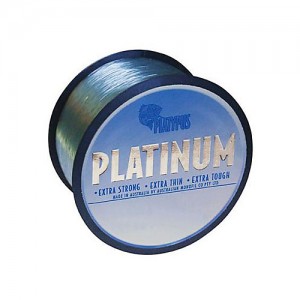 Platypus Platinum: A great all-round line that is soft, subtle and packs well on the reel. It is one of Australia’s most popular fishing lines and can be found in most tackle stores.
Platypus Platinum: A great all-round line that is soft, subtle and packs well on the reel. It is one of Australia’s most popular fishing lines and can be found in most tackle stores.
[divider padding=”8″]
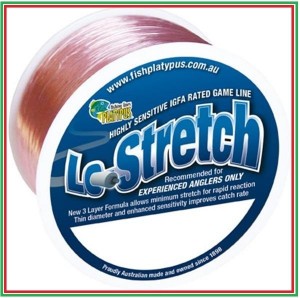 Platypus Lo-Stretch: A marginally stiffer line than Platinum but works well on the Alvey Reels as it actually turns the swivels well and helps reduce line twist. Lo-Stretch is also great in boating situations as hook-up rates can be increased as a result of the lower stretch. It is also one of very few IGFA rated monofilament lines so tournament anglers have adopted it’s qualities with open arms.
Platypus Lo-Stretch: A marginally stiffer line than Platinum but works well on the Alvey Reels as it actually turns the swivels well and helps reduce line twist. Lo-Stretch is also great in boating situations as hook-up rates can be increased as a result of the lower stretch. It is also one of very few IGFA rated monofilament lines so tournament anglers have adopted it’s qualities with open arms.
[divider padding=”8″]
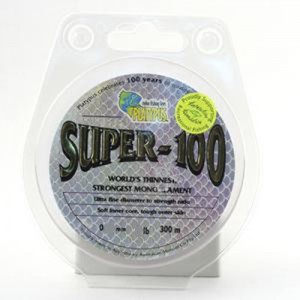
Super100: I absolutely love this line! It isn’t the cheapest line on the market but its qualities are second to none making it worth every cent. Super100 was developed by Platypus to celebrate the company’s 100th year of manufacturing in Australia and what an amazing job they did. It has an incredibly thin diameter thus reducing the effect of current sweep and also adding to the amount of line that can be packed onto the reel. Super100 also retains fantastic knot strength for such a fine line!
[divider]
Best Beach Fishing Baits
The great thing about beach fishing is that many of the baits we use are found right on the beach providing us with a fresh (and cheaper) alternative to frozen processed baits. Of course it’s always worth visiting your local tackle store and taking a supply of frozen bait just in case you don’t find any fresh bait; just remember you will always catch more on fresh bait if available!
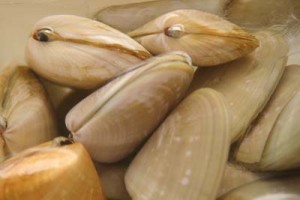 Pippie (Eugarie)
Pippie (Eugarie)
Found in abundance on many coastal beaches the “Pippie” as it is affectionately called is prime bait for Bream, Tarwhine, Whiting, Swallowtail Dart and many other species. Pippies are easily located by looking for small sandy ‘bumps’ usually around mid to low water levels. They can be retrieved by dragging your finger through the sand where you find a bump. Pippie are normally rigged on smaller single hooks from size 4 to 2/0
[divider padding=”8″]
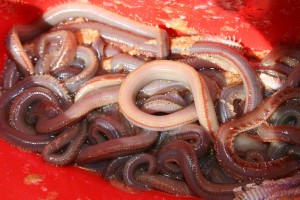 Beach Worm
Beach Worm
One of the best baits for beach fishing is the humble beach worm. It will catch anything from Bream, Whiting & Dart through to mammoth Jewfish when fished in large clumps.
The beach worm is also favoured due to its resistance to falling off the hook when scavengers are about. If you haven’t yet caught them it takes practice and perseverance so you may want to stock up at your local tackle store if you haven’t mastered the ‘art’ of beach worming. A great tool for the job is a pair of Alvey Beach Worming pliers that have tiny nodules to assist gripping these lightning fast critters. There are a number of videos available on the internet that show how it’s done.
[divider_padding]
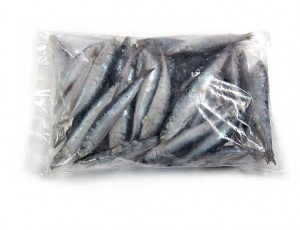 Pilchard
Pilchard
The Pilchard or Sardine are usually purchased in bags or ‘blocks’ and are an irresistible bait when Chopper Tailor or Salmon are on the boil. Fished on 3 or 4 gang hooks they can be fished by either casting out and retrieving when the pelagic fish are schooling, or simply letting them sit. Its amazing how many fish will eat the pilchard so be prepared for anything at the business end of the line! They can get soft if allowed to thaw so make sure they are kept separate from any water slurry if using ice. I use a plastic container on the ice to keep them in prime condition. For extended beach fishing trips salting them down is a great idea (see ‘Salting Flesh Baits’)
[divider_padding]
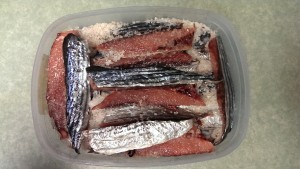 Bonito
Bonito
The Bonito is my all time favourite bait when beach fishing for large Greenback Tailor. The oily flesh is like a calling card to the Greenback but it will also attract many other predatory species like Jewfish and Shark. The flesh is best used salted if time allows and if done correctly will remain intact for a number of casts. I fish Bonito on two gang rigs which normally consist of a 5/0 & 3/0 combination. Flesh should be filleted length ways (with the grain) and baits are normally cut to about 3 to 4 inches.
[divider_padding]
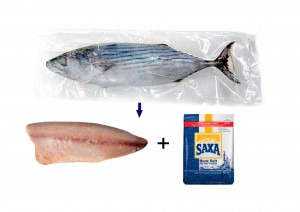 Salting Flesh Baits
Salting Flesh Baits
Salting is done to preserve your flesh baits like Bonito and Pilchard. The tough firm bait will not fall apart when casting and will also last much longer, sometimes allowing a number of casts before needing to re-bait.
Here’s my step by step guide to salting Bonito, usually done 3 – 4 days before your beach fishing trip:
- Allow your Bonito to thaw but only to the point the flesh is just cuttable. This will ensure the guts remains intact and makes far less mess.
- Fillet the Bonito and cut each fillet in half again, make sure this ‘halving’ cut is lengthwise and not across the fillet. Each fish therefore provides 4 strips.
- Place a layer of course Rock-Salt over the bottom of a plastic container and place a layer of fillet flesh side down onto the rock salt.
- Repeat the process until you have used up all your fillets.
- Place in the freezer for 24hrs and then drain the water that pools on the bottom of the container. You will need to drain the water daily for 2 -3 days until all the water has been drawn out of the fillets. They will now be tough, leathery and prime bait for your big adventure!
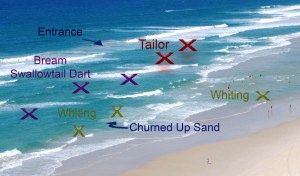 Choosing your Beach Fishing Location:
Choosing your Beach Fishing Location:
Like most forms of fishing it’s best to target a particular species as your choice will ultimately define where you fish. Once you have found a likely location, the direction of ‘sweep’ (current) will play a huge part in where you fish as most ‘bread & butter’ species feed where sand is being churned up around the surrounding sand bank.
If you are driving along at low tide look out for steep gradients in the beach and mark these on your GPS or take visual landmarks as these locations will be prime spots to return to for the high tide.
Which fish and what to look for:
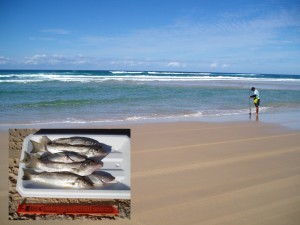 Whiting – Low tide drains and areas where sand is being churned up by current will often hold large congregations of whiting. It’s often best to first flick bait from a distance to the waters edge as whiting often patrol the shallow foreshore areas and the edge of ‘drop-offs’ looking for pippies, worms and other nutrient being washed about in the slop. Use size 4 or 6 long shank hooks as whiting tend to scoff the bait and the long shank hooks are easier to remove. The long shank is also ideal for threading beach worm.
Whiting – Low tide drains and areas where sand is being churned up by current will often hold large congregations of whiting. It’s often best to first flick bait from a distance to the waters edge as whiting often patrol the shallow foreshore areas and the edge of ‘drop-offs’ looking for pippies, worms and other nutrient being washed about in the slop. Use size 4 or 6 long shank hooks as whiting tend to scoff the bait and the long shank hooks are easier to remove. The long shank is also ideal for threading beach worm.
[divider padding=”8″]
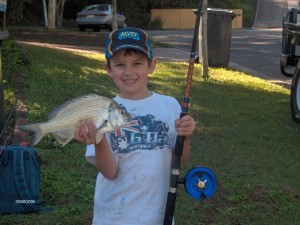 Bream – Usually found in deeper holes and commonly tucked in close to sand bars where currents are churning the sand into the deep water. If there is structure on the beach (rocks, timber debris etc.) you have an excellent chance of finding Bream here too. Using number 1 or 1/0 bait holder hooks with fresh Pippie or worm will increase your success.
Bream – Usually found in deeper holes and commonly tucked in close to sand bars where currents are churning the sand into the deep water. If there is structure on the beach (rocks, timber debris etc.) you have an excellent chance of finding Bream here too. Using number 1 or 1/0 bait holder hooks with fresh Pippie or worm will increase your success.
[divider padding=”8″]
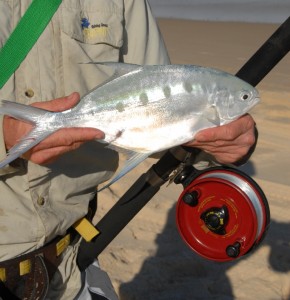 Swallowtail Dart – These speedy little guys love the action. They cruise the waves in packs and can be found in many locations but are most commonly caught on sand bars and off the edges of sand banks feeding in the wash. Keeping your bait moving slowly can increase the chances of a strike. Dart will climb all over both Pippie and Beach Worm and have fairly small mouths so keep hook size to size 4 for better hook ups.
Swallowtail Dart – These speedy little guys love the action. They cruise the waves in packs and can be found in many locations but are most commonly caught on sand bars and off the edges of sand banks feeding in the wash. Keeping your bait moving slowly can increase the chances of a strike. Dart will climb all over both Pippie and Beach Worm and have fairly small mouths so keep hook size to size 4 for better hook ups.
[divider padding=”8″]
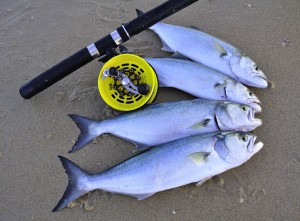 Tailor – Deep gutters that have double exits are the best place to find big Tailor. By this I mean a sandbar out the back with deep clear water either side and also between it and the beach (See diagram). A gutter with only one entrance will also do the job but higher success rates occur when gutters with both exit points can be located. Tailor use the white water as cover and usually feed both on the bank and under the frothy white water spilling back into the deep gutters.
Tailor – Deep gutters that have double exits are the best place to find big Tailor. By this I mean a sandbar out the back with deep clear water either side and also between it and the beach (See diagram). A gutter with only one entrance will also do the job but higher success rates occur when gutters with both exit points can be located. Tailor use the white water as cover and usually feed both on the bank and under the frothy white water spilling back into the deep gutters.
[divider padding=”8″]
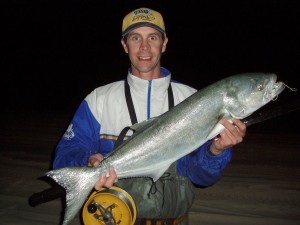
Big ‘Greenback’ tailor are predatory speedsters and will hit your Bonito or Pilchard hard as opposed to smaller chopper tailor which often feed with a more subtle ‘rat a tat tat’ kind of bite. Tailor are also a nocturnal fish that will use the cover of dark nights to hunt. On these nights using a large Glow Bead or Lumo strip over the wire trace can increase the hook up rate. Two hook rigs (5/0’s) ganged with a swivel and a short wire trace are perfect for your salted Bonito baits. Use a large sinker (8 to10 ball) to secure your bait and don’t be afraid to set your rod in a sand spike with just enough drag pressure to assist setting the hook.
[divider padding=”8″]
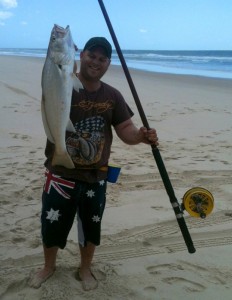 Jewfish – Big Jewfish are often the pinnacle of many beach fishos dreams. They are not a common catch but perseverance and dedication may see you handsomely rewarded. Jewfish are best targeted on darker nights on beaches that are in close proximately to rocky structure such as a headland or break-wall. Big baits such as fresh Tailor fillet, fresh Squid or a bunch of beach worms are prime baits for the elusive Jewfish. Baits are generally placed on snelled 2 hook rigs with sturdy 8/0 to 10/0 hooks and heavy Fluorocarbon leader (60 – 80Lb) being used for protection.
Jewfish – Big Jewfish are often the pinnacle of many beach fishos dreams. They are not a common catch but perseverance and dedication may see you handsomely rewarded. Jewfish are best targeted on darker nights on beaches that are in close proximately to rocky structure such as a headland or break-wall. Big baits such as fresh Tailor fillet, fresh Squid or a bunch of beach worms are prime baits for the elusive Jewfish. Baits are generally placed on snelled 2 hook rigs with sturdy 8/0 to 10/0 hooks and heavy Fluorocarbon leader (60 – 80Lb) being used for protection.
[divider_padding padding=”8″]
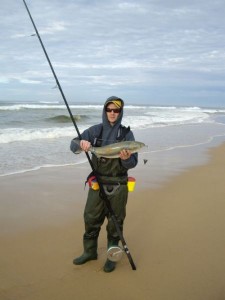 Beach Fishing Tips & Etiquette:
Beach Fishing Tips & Etiquette:
Below are a few added tips which I have gained from experience that I think may make your beach fishing experience more rewarding.
- If you are fishing in an area with even the slightest sweep cast out and walk slowly along the beach with your line. This prevents your line getting washed back onto the beach and causing huge amounts of line twist from the barrelling waves. You will also cover more ground and catch more fish. If fishing in a group make sure everyone understands and simply walk along together and rotate positions.
- Use a swivel either side of your running sinker to reduce line twist (1ft). The surf can cause severe line twist if not fished correctly but using a swivel as the first item in the rig (closest item in rig to angler) can reduce this effect considerably.
- Snap on ‘Klik Sinkers’ are a brilliant new concept. These hinged sinkers simply snap onto your line allowing you to quickly change size as current changes on the beach. They can also be easily removed when travelling which eliminates the sinkers damaging your rod or your vehicle. I love them when pre-rigging as I place my rigs in snap-lock bags and decide which sinker weight is required once assessing water condition.
- Many large fish like Greenback Tailor and Jewfish are nocturnal and easily spooked when light shines on the water, so always keep bright lights off the water. This includes headlamps and vehicle headlights! Turn around when baiting up at night so that your headlamp shines back towards the beach and not into the water. If you are approaching fishermen at night on a beach in your vehicle, drop your high beam, slow right down and be cautious. An Alvey Premium Wading Bag is a great asset as it has a highly visible reflective panel which alerts drivers to your presence on the beach.
- Give fellow fishers space and don’t cast over their lines. If unsure of the sweep, have a look at other fishermen’s lines so you know which way your line will face if not walking the beach. The surf can make a huge mess of two entangled fishing lines!
- Other important Alvey accessories to consider that will make your fishing trip far more comfortable include a Wading Bag, Large Bait Bucket, Rod Bucket, Knife, Fish Measure and Beach Worming Pliers. Also, don’t forget spare batteries for your head torch!
- If your intention is to take home a healthy feed it’s imperative to ice your catch so that it flesh remains in the best possible condition. Always bleed your catch by cutting its throat and place the fish into a salt water slurry made up of ice and sea water.
- Always check your local fisheries size and bag limits and if unsure throw them back. Alvey fish measures (40cm & folding 80cm version) are made here in Australia and are updated to reflect local state laws as required. I believe they are they most reliable fish measure on the market in Australia!
- If you are planning on wearing Waders in the surf, it is not just a matter of finding a pair that fit in your local bait and tackle store and go fishing. Please consider these additional safety points:
- Go a size larger in the boots, if you need to get them off in a hurry it is much easier! Also in Winter we normally wear thicker woolly socks to keep your feet from going numb!
- Buy or use a pair of wader that come with a “Chest Strap” This could be one of the most important parts…. If you don’t have a “Chest Strap” and you get hit by a wave or if you fall in a hole, your waders will fill up very quickly with freezing water. Waders full of water will also drag you down under the water which could turn an awesome family holiday into a tragic memory.
- Check your waders before you leave home for any signs of damage from years of use, rats, mice and any other critter that like to chew on your expensive equipment!
- Help to avoid embarrassing moments and use the toilet before you put your waders on and head out!
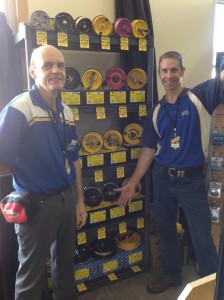 Enjoy
Enjoy
Beach fishing is something that will bite you and stay with you for life. It is the most relaxing form of fishing bar none and once you understand the basics you will never look back. It can be a hostile environment to the ill-prepared but with the right gear (Alvey), right advice and right bait you will be well on your way to understanding the pleasures of beach fishing! Rob Duncan <*))><
[divider_padding]
Special Thanks:
Tackle Land would like to say that this Beach Fishing artical has enlightend us some what so we certainly hope you have been able to take some key information as well!
A special thank you and well done to Rob Duncan for sharing nearly 20 years of learning and experience with us all.
Thanks also to Alvey Reels Australia for allowing us to document this information and to be able to share with our readers. Without Alvey Reels Australia, Beach Fishing would not be as exciting and as easy as it is today!
If you would like to see a full range of the best “Australian Made” Beach Fishing gear, check out:
Their Web Page : “Alvey Reels Australia” or
Face Book: “Alvey Reels Austalia – Facebook”
Comments:
If you have any information that you would like to add from your own Beach Fishing experiences, please make comment in the area below.
The more we all share the more we all learn and hopefully everyone will have an awesome experience and will venture out as a family or a group of mates to experience some of the best beach fishing and some of the best camping locations in the world!
Maintain the Passion!

19 Comments
Remember… it’s the Alvey Reel that fills the creel. And we fondly and gratefully remember Jack Alvey, Keith Peele, Ben Perkins, Al Sanders …et al !
Hi
you mention above to put the bonito fillets in the freezer for 24 hours when salting, and then drain the water, but won’t the water be frozen if it’s in the freezer? or should it be in the fridge?
thank!
Jamie, some people will do it either way but when things get salted it reduces the water content thus reducing the freezing process.
Great question, thanks for taking the time to ask.
Great information!
I have around six Alvey reels and have to make my own rods up because there not that popular in England!
Do you know where I can get an Alvey baseball type fishing cap in England?
Hey, just thought, I will contact Alvey.
Thanks for the great info!
Mark
Hi Mark, I would suggest going straight to Alvey on this one, great company and plenty of support. Good luck and maintain the passion!
hi that very interesting about putting your salted baits in the freezer,i was always told and i am not young by the way when ever you put the bait you have just salted in the freezer it will stop the slting process and drawing
moisture from the bait . the way i have been taught is to get a container like a small esky that has a bung at kne end throw down a layer of rock salt put you cut fillets of fish skin down followed by another layer of salt
repeat the process until you have run out of bait to salt finaly finishing with a top layer of salt make sure the esky or container that has a tap or bung has a air tight fitting lid.
I will leave for 24 hours then drain of what moisture that has been extracted from the bait i to a air tight jar
this process is repeated every full day until no more moisture can be extracted ,i then shake off the excesive salt from the filtets dry the fillets with paper towell the. wrap up in news paper and place in the crisper of the fridge
by doing it this way you have a bait that will be firm and tough and will keep for quite some time i have just finished using up the last big of my salted couta which i have had for over 4 months all my fish fillets are all done the same way and i have even done squid like this plus chicken fillets prawns you name i have done it andtried it
thats my five pence worth cheers and tight lines.
Thanks for your feedback Rick, They are plenty of methods to salt down your bait. I like the idea you have of using an esky with a bung, this will save making a lot of mess! I appreciate you taking time to pass on your knowledge to us and our readers, Thanks again and Maintain the Passion!
What breaking strain mono would you suggest for the larger surf setup?
Hi Terry, we would normally use a 30lb Mono off the beach but if you are doing a bit of Rock Fishing I would step it up to about 50lb purely for the lifting capability.
1st time reader, fantastic range of information, very interesting and useful. As from Bargara, this info will be worth trying on our beaches up here, thank you, don’t stop posting.
Awesome work Greg! We are glad that you took the time to have a read, you never know, something may work at Bargara!Happy Hunting…
Hi I’m an Englishman coming to Queensland and hoping to do some surf fishing around the Labrador
area. Would fishing the surf the same way i do in England work for me. I’m not even sure there is an
appropriate surf in Labrador I’m only going by what my Daughter has told me regarding places to fish
the surf.
Could you give me any tips please
John
Awesome to read, Idea is very clean and most of the points are valuable to make fish hunting ease and result oriented. For making result we need good preparation and this content can helps us a lot. Thanks
Hi Mark,
Just purchased my first Alvey beach set up, cant wait too get out and use it. ( R65C and 65GVCR ).
Your advice and knowledge on this page is and has been so informative.
Thanks so much !!
Please keep up the good work and info for us newbies to great Alvey gear.
Olly ( Perth ).
Olly, it is really good to hear that you are excited! We must warn you that you will not stop at one!!
We hope that you get yourself some awesome memories while out there doing what you love.
Enjoy and report back on your adventures.
Thanks for this awesome piece Rob, very informative for someone like myself who is taking up fishing, no I know what to look for when purchasing gear and heading out to the beach… hopefully I catch something:)
Very informative post! There is a lot of information here that can help any business get started with a successful social networking campaign
Thanks for your sharing.
Jullia, thank you for your comment and for taking the time to have a read.